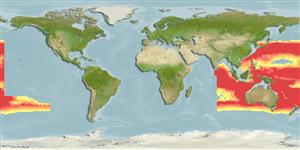Classification / Names
Common names from other countries
Main reference
Size / Weight / Age
Max length : 22.0 cm TL male/unsexed; (Ref. 6871)
Length at first maturity
Lm ?, range 15 - ? cm
Environment
Marine; bathypelagic; depth range 200 - 2000 m (Ref. 6871)
Climate / Range
Deep-water, preferred ?
Distribution
Short description
Dorsal
spines
(total): 1;
Dorsal
soft rays
(total): 0;
Anal
spines: 0;
Anal
soft rays: 0. The smalleye pygmy shark, Squaliolus aliae, is a very small dogfish (about 22cm) characterized by its small eye, with diameter about 46-70% of interorbital width, and with upper margin angular and chevron-shaped; upper lip with a pair of prominent lateral papillae (rarely indistinct) (Ref. 31367, 6871).Colour: dark brown to black, fin margins pale (Ref. 6871). Squaliolus are the only sharks with a fin spine on its first dorsal fin (spine sometimes concealed by skin) but not on its second dorsal fin; second dorsal fin long-based and low, about twice the length of the first dorsal fin base; first dorsal-fin base closer to pectoral fins than to pelvic fins; and caudal fin nearly symmetrical, with subterminal notch present (Ref. 247, 6871).
IUCN Red List Status (Ref. 115185)
Threat to humans
Harmless
Human uses
Fisheries: of no interest
More information
Age/SizeGrowthLength-weightLength-lengthLength-frequenciesMorphometricsMorphologyLarvaeLarval dynamicsRecruitmentAbundance
ReferencesAquacultureAquaculture profileStrainsGeneticsAllele frequenciesHeritabilityDiseasesProcessingMass conversion
Tools
Special reports
Download XML
Internet sources
Estimates of some properties based on models
Phylogenetic diversity index
PD50 = 0.7520 many relatives (e.g. carps) 0.5 - 2.0 few relatives (e.g. lungfishes)
Trophic Level
4.4 ±0.57 se; Based on food items.
Resilience
Low, minimum population doubling time 4.5 - 14 years (Fec assumed to be <100)
Vulnerability
Low vulnerability (11 of 100)
Price category
